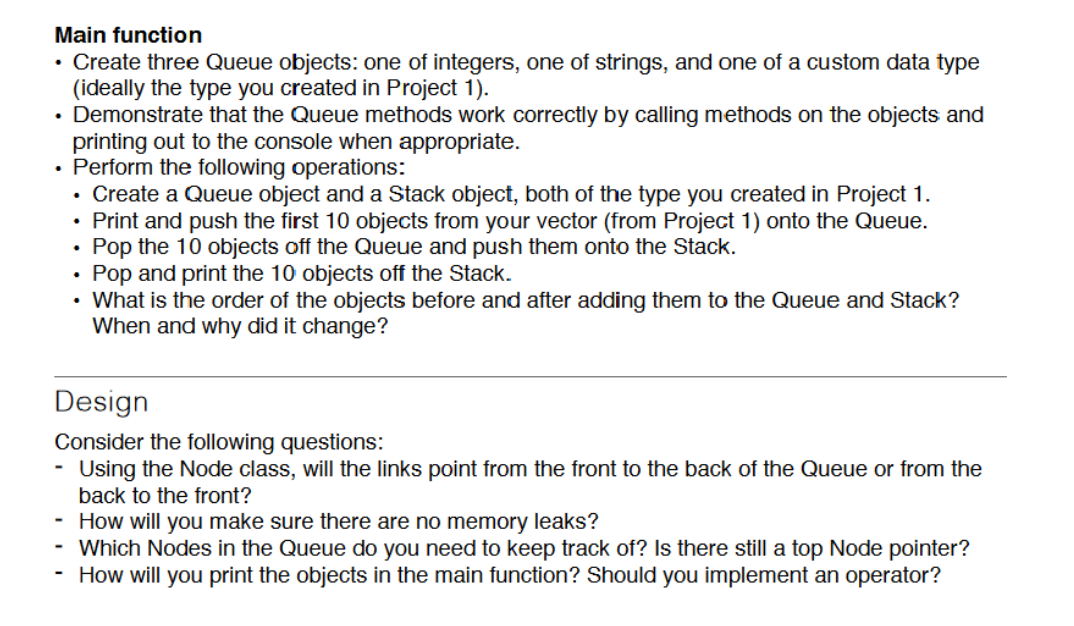Question
All the following code is below. Stack.h, Node.h and Queue.h were pre-written, and the code after that is from Project 1 (which is seen in

All the following code is below. Stack.h, Node.h and Queue.h were pre-written, and the code after that is from "Project 1" (which is seen in the directions).
Stack.h:
#ifndef NODEB_STACK_H #define NODEB_STACK_H #include "Node.h" #includeusing namespace std; templatetypename Object> class Stack { private: Node
Node.h:
templatetypename Object> class Node { private: Object item; Node* next; public: Node(Object newItem) { item = newItem; next = nullptr; } Node(Object newItem, Node* nextNode) { item = newItem; next = nextNode; } void setItem(Object newItem) { item = newItem; } Object getItem() const { return item; } void setNext(Node* nextNode) { next = nextNode; } Node* getNext() const { return next; } }; Queue.h:
#includeusing namespace std; templateclass t> struct node { t info; node * next; }; templateclass t> class queuetype { node * f; node *r; public: queuetype() { f = NULL; r = NULL; } void insertion(node *); node * deletion(); int isempty(); void display(); node * createnewnode(t); };
Now, the following code is from the "Project 1" that the directions reference. Basically, I wrote code that takes a text file containing information on different football players and their combine results, stores those players as a vector of objects of the class, and prints out those objects. Finally, I wrote a function that calculates the average weight of the players.
Combine.h:
#include#include #include #include #include #include using namespace std; class Combine { private: string name, college, pos; int height, weight; float dash, bench; public: Combine() { name = "John Smith"; college = "University"; pos = "player"; height = 0; weight = 0; dash = 0; bench = 0; } Combine(string name, string college, string pos, int height, int weight, float dash, float bench) { this->name = name; this->college = college; this->pos = pos; setHeight(height); setWeight(weight); setDash(dash); setBench(bench); } string getName() const { return name; } string getCollege() const { return college; } string getPos() const { return pos; } int getHeight() const { return height; } int getWeight() const { return weight; } float getDash() const { return dash; } float getBench() const { return bench; } void setName(string name) { this->name = name; } void setCollege(string college) { this->college = college; } void setPos(string pos) { this->pos = pos; } void setHeight(int height) { if (height //Default value this->height = 0; } else { this->height = height; } } void setWeight(int weight) { if (weight this->weight = 0; } else { this->weight = weight; } } void setDash(float dash) { if (dash this->dash = 0; } else { this->dash = dash; } } void setBench(float bench) { if (bench //Default value this->bench = 0; } else { this->bench = bench; } } friend ostream& operatorconst Combine &com) { outs return outs; } }; void getPlayersFromFile(string filename, vector &players) { ifstream inFile; inFile.open("../" + filename); string name = "", college = "", pos = "", header = ""; string temp; int height = 0, weight = 0; float dash = 0, bench = 0; char comma = ','; if (inFile) { getline(inFile, header); while (inFile && inFile.peek() != EOF) { getline(inFile,temp); stringstream ss(temp); getline(ss,name,','); getline(ss,college,','); getline(ss,pos,','); getline(ss,temp,','); height = atoi(temp.c_str()); getline(ss,temp,','); weight = atoi(temp.c_str()); if(ss.good()) { getline(ss,temp,','); dash = atof(temp.c_str()); } else{ dash=0; } if(ss.good()) { getline(ss,temp,','); bench = atof(temp.c_str()); } else{ bench=0; } players.push_back(Combine(name, college, pos, height, weight, dash, bench)); } } else { cerr "File not found" float avgWeight(vector &players) { float total = 0; getPlayersFromFile("CombinePlayers.txt", players); for (int i = 0; i } cout "The average weight of a player is: " "lbs" Main.cpp:
#include "Combine.h" #includeusing namespace std; int main() { vector players; getPlayersFromFile("CombinePlayers.txt", players); for (int i = 0; i cout return 0; } CombinePlayers.txt:
Name, College, POS, Height (in), Weight (lbs), 40 Yard, Bench Press Johnathan Abram, Mississippi State, S, 71, 205, 4.45, 0 Paul Adams, Missouri, OT, 78, 317, 5.18, 16 Nasir Adderley, Delaware, S, 72, 206, , 0 Azeez Al-Shaair, Florida Atlantic, LB, 73, 234, , 16 Otaro Alaka, Texas A&M, LB, 75, 239, 4.82, 20 Dakota Allen, Texas Tech, LB, 73, 232, 4.77, 23 Josh Allen, Kentucky, EDG, 77, 262, 4.63, 28 Zach Allen, Boston College, DE, 76, 281, 5, 24Main function Create three Queue objects: one of integers, one of strings, and one of a custom data type (ideally the type you created in Project 1). Demonstrate that the Queue methods work correctly by calling methods on the objects and printing out to the console when appropriate. Perform the following operations: Create a Queue object and a Stack object, both of the type you created in Project 1. Print and push the first 10 objects from your vector (from Project 1) onto the Queue. Pop the 10 objects off the Queue and push them onto the Stack. Pop and print the 10 objects off the Stack. What is the order of the objects before and after adding them to the Queue and Stack? When and why did it change? Design Consider the following questions: - Using the Node class, will the links point from the front to the back of the Queue or from the back to the front? - How will you make sure there are no memory leaks? - Which Nodes in the Queue do you need to keep track of? Is there still a top Node pointer? - How will you print the objects in the main function? Should you implement an operator? Main function Create three Queue objects: one of integers, one of strings, and one of a custom data type (ideally the type you created in Project 1). Demonstrate that the Queue methods work correctly by calling methods on the objects and printing out to the console when appropriate. Perform the following operations: Create a Queue object and a Stack object, both of the type you created in Project 1. Print and push the first 10 objects from your vector (from Project 1) onto the Queue. Pop the 10 objects off the Queue and push them onto the Stack. Pop and print the 10 objects off the Stack. What is the order of the objects before and after adding them to the Queue and Stack? When and why did it change? Design Consider the following questions: - Using the Node class, will the links point from the front to the back of the Queue or from the back to the front? - How will you make sure there are no memory leaks? - Which Nodes in the Queue do you need to keep track of? Is there still a top Node pointer? - How will you print the objects in the main function? Should you implement an operator
Step by Step Solution
There are 3 Steps involved in it
Step: 1

Get Instant Access to Expert-Tailored Solutions
See step-by-step solutions with expert insights and AI powered tools for academic success
Step: 2

Step: 3

Ace Your Homework with AI
Get the answers you need in no time with our AI-driven, step-by-step assistance
Get Started


